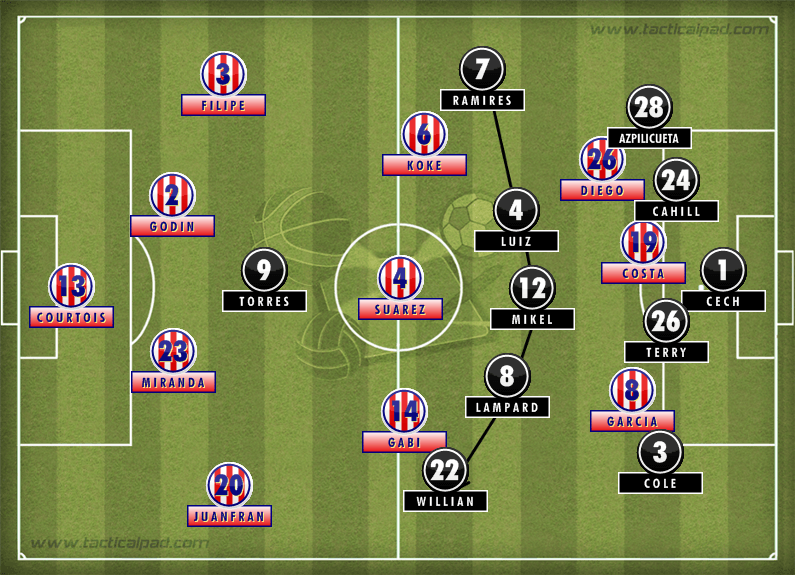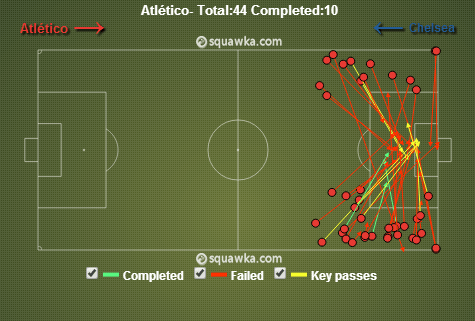Atletico Madrid and Chelsea went head-to-head at the Vicente Calderon in the Champions League semi-finals. It was a tactical battle that was certainly not pleasing to the eyes, it was never going to be. Both sides are in their respective title races but Atletico Madrid are in a much better situation while Chelsea’s contention could come to a halt this weekend. Mourinho has been desperate for a Champions League with Chelsea, and a record third with a different club while Atletico Madrid are looking forward to a first final in 40 years.
Atletico Madrid 0-0 Chelsea


Atletico Madrid: Courtois, Miranda, Godin, Torres, Luis, Gabi, Suarez (Sosa 80′), Koke, Garcia (Villa 86′), Diego (Turan 60′), Costa
Chelsea: Cech (Schwazer 18′), Terry (Schurrle 73′), Cahill, Azpilicueta, Cole, Mikel, Luiz, Lampard, Willian (Ba 90′), Ramires, Torres
JOSE TAKES ADVANTAGE OF ATLETICO’S CENTRE-BASED APPROACH
Now as we know, Diego Simeone’s Atletico Madrid bank on making their own midfield compact and forcing the opposition to play from wide areas. This tactic has helped them against the big two of Spain, Barcelona and Real Madrid, against whom they’ve played seven games across three competitions and emerged unbeaten in all (losing to Barca in the Supercopa on away goals). But after their Spanish counterparts, Atletico’s next big opposition have been Jose Mourinho’s Chelsea, and their central based football suited the London club well.
Chelsea banked on Atletico trying to make it compact in defence and forcing the opposition out wide and instead made their own midfield compact and forced Atletico out-wide without going wide themselves. Smart, isn’t it? To put it plainly, Atletico make it tight in midfield and force the opposition to use the wings. Chelsea did exactly what Atletico do. So now both teams are making it compact in midfield, hoping/forcing the opposition out-wide. Now with Atletico playing at home, they gave in and moved it wide while Chelsea still refused to do so.
The idea behind forcing teams wide negates their creativity from midfield and allows the opposition to put crosses into the box which the team feels their defence can deal with. Atletico’s defence can deal with crosses well, and so can Chelsea’s. So as it happened, Atletico were the team to concede in the battle and take their troops wide putting in crosses and hoping that an Atletico man managed to come onto the end of it.

Atletico Crosses (via Squawka.com)
Atletico Madrid attempted a remarkable 44 crosses, of which only 10 were succcessful. Compare that to Chelsea, who attempted just 5 crosses, all unsuccessful and all coming from corners. Of the 10 crosses that Atletico did find to be successful 6 were aerial duels won by Raul Garcia, the false target man (see articles). The 27-yr-old made late runs from the right into the box and even tried dropping deep in a bid to win the duel in the air and was successful, the knock downs though, were dealt with by the Chelsea defence. A remarkable battle of wits, which one must say was edged by Mourinho.
FERNANDO TORRES THE WRONG MAN FOR THE SYSTEM
Mourinho said post game that no manager ever goes into the game looking for a 0-0, and that circumstances force sides to set-up eventually and be content with a 0-0. We beg to differ Jose, plenty of managers and teams go into games looking for just a draw and have proved to be successful at it too. The point Mourinho was trying to make, as he went on to explain, was that he did set-up defensively and grew more defensive as the game progressed, and the idea remained that they would attempt to score with a quick break. On this, we’ll agree with Mourinho. But while he did win the battle in one area, he got it completely wrong in the other.
Given Fernando Torres’ well-documented fall from grace, it is always going to be hard to say what system/approach suits the ex-Atletico man well. As one of our followers on Twitter suggested “Fernando Torres isn’t a fit candidate for any system”. A discussion for another day that.
But Fernando Torres was definitely not the right option for the system Mourinho employed against Atletico. The man upfront was always going to be isolated, but with his strength, hold up play and movement, should be able to carve out some sort of chances and score against the run of play (or atleast attempt to score). Drogba has long done that in his Chelsea days. People will be quick to point out the lack of service to Torres, but that was something that Drogba faced as well, and dealt with.
MORE READING: Atletico Madrid Tactics: Part 1 | Basic Formation & Set-Up
Atletico Madrid Tactics: Part 2 | Build-up play from Defence & Midfield
Atletico Madrid Tactics: Parth 3 | Set-up in the Attacking-Third
Torres was lethargic on the field, couldn’t make his presence felt at all throughout the game and it was even suggested that his role was possibly to mark Godin and Miranda, prevent them from attacking. A cheeky snide at Torres that, but it certainly looked like that. He wasn’t coming on to the ball, just made the numbers as Chelsea needed to field eleven players.
There was a point in the game where Chelsea did break, and a 2-on-2 situation developed. Ramires took the ball forward, and played a quite pointless ball across which went out for a goal-kick. Ramires did receive blame for that, but one could cast their eyes on Torres and question what in the world he was doing. He did give a look down to his feet, almost to say “don’t give up on me”, and put in all his effort to get across into a dangerous position as any lone striker would. The result was a jog that barely got him half-the-way across where he should have been, at the end of Ramires’ ball.
It would certainly have been beneficial if Torres atleast tried to press opponents, even though the rest of the side weren’t (they had to stick to their organisation, Torres didn’t). He could have pressed the midfield, but he stayed up ahead ‘marking’ the defence. There was a moment in the game where Azpilicueta got into Atletico’s half, late on, pressing Atletico and forcing the ball back, almost setting an example for Torres to follow.
ATLETICO FAIL TO EXPLOIT THE SPACE BETWEEN THE LINES
Chelsea’s defensive set-up saw them playing with two lines in defence. A solid back-four that stuck to their task, and a five-man midfield that did it’s duty remarkably well too. The likes of Mikel, Ramires & Luiz are astute at playing a defensive game, but Willian too was able to play a mature game and stick to his task while Frank Lampard seemed a bit lost in midfield.
Nonetheless, Chelsea’s plan of compacting the midfield, not allowing Atletico to play through the centre was well-set up and did it’s duty as prescribed. Diego Simeone needed to find a system to play past this two walls of defense, and starting with Diego Ribas was a good option. The Brazilian could slot in well just behind the striker and ‘false-target-man’ (see articles above for more) and try and exploit the little pockets of space that are bound to develop, despite the rigid Chelsea organisation. You could see moments in the game where Chelsea would break through and a small gap develop in that congested central area.

That gives you an idea how deep they were (via Squawka.com)
But unfortunately, Diego and the Atletico system didn’t take advantage of this with the ex-Juventus man primarily trying to play in the attacking third. He could have possibly tried to fall deeper and not make it that easy for Chelsea in midfield, but with no one offering themselves there, it eased the pressure on the midfield as they now had to just contend with any oncoming traffic from midfield as opposed to the attackers dropping deeper. It forced Atletico into a different system, which we explained above.
It must be noted that Chelsea didn’t force Atletico off-the-ball. There was no pressing, Chelsea allowed Atletico all the time on the ball and opted to remain organised. They were certain that allowing Atletico on the ball would only result with them going wide and putting crosses in, something they trusted their abilities in dealing with and did so.
WHERE DOES THIS LEAVE THEM?
A 0-0 doesn’t put either team in more of an advantage than the other. Chelsea will say they have home advantage and are likely to score but Atletico Madrid will realise that if they manage one goal, they’ll be at a huge advantage. You’d have to expect Atletico to get on the scoresheet once atleast, and Chelsea will have to be more efficient in their attacking. Their defensive concerns are obviously worrying but their suspensions leaves them short in midfield.
Jose will consider a 0-0 as a good result without some key players, but they seems to have come off worse in terms on injuries and this could cost them. Another intriguing tactical battle awaits.
For more Tactical Analysis of the biggest games, head this way.


























































